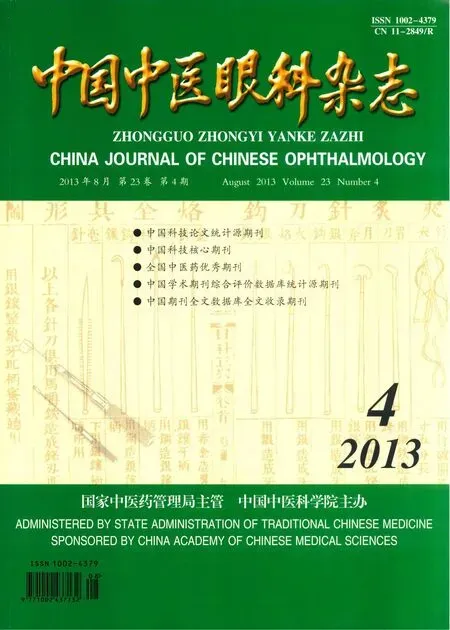PDT的副作用及其防治
侯 乐 谢立科 唐由之 肖文峥 张明明 郝晓风 谢万坤
光动力学疗法(photodynamic therapy,PDT)是一种选择性损伤疗法,最早用于恶性肿瘤的诊断和治疗,上世纪末被应用于临床封闭脉络膜新生血管(choroidal neovascularization,CNV),并逐渐引入到许多眼底病的治疗当中。本文对目前PDT应用中所发现的问题及针对相应问题所作出的改进进行简单介绍。
1 PDT的主要应用范围及不足之处
PDT由于其组织选择性好、对微血管组织的损伤作用强和全身副反应少等特点,曾被认为是治疗多种CNV相关眼底病的首选疗法,并主要应用于年龄相关性黄斑变性(age related macular degeneration,ARMD)、息肉样脉络膜血管病变(polypoidal choroidal vasculopathy,PCV)、病理性近视(pathologic myopia,PM)和中心性浆液性脉络膜视网膜病变(central serous chorioretinopathy,CSC)的治疗中。但是经过几年的随访观察及临床研究,发现PDT也有不可忽视的副作用。
1.1 视力不改善甚至降低
研究发现,PDT虽然能有效地减慢湿性ARMD病程,但其几乎不能提高视力〔1〕。Kürzinger GR等人在PDT对有隐匿性新生血管的ARMD疗效研究中发现,PDT能稳定却不能提高湿性ARMD患者的矫正视力〔2〕。Keane等人报道了1例ARMD患者在PDT治疗后出现了急性的视力下降〔3〕。同时,有研究表明,应用PDT治疗病理性近视长期疗效明显低于贝伐单抗(bevacizumab),并且在PDT治疗2年后,视力较治疗早期明显下降,与未治疗前的基线视力无明显差异〔4-5〕。
1.2 对脉络膜和视网膜的副作用
1.2.1 严重的脉络膜局部缺血和萎缩:CSC伴有浆液性视网膜色素上皮脱离(pigment epithelium detachment,PED),或慢性CSC患者经PDT治疗后,虽然PED及浆液性视网膜神经上皮脱离复位,但其激光治疗区域出现严重的脉络膜局部缺血并导致视力下降〔6〕。对于需要多次PDT治疗的CNV相关眼底病,反复的PDT治疗会增加永久性脉络膜萎缩的风险〔7〕。
1.2.2 视网膜下/脉络膜上出血:部分PCV患者在PDT治疗不久后出现大量的视网膜下/脉络膜上出血〔8〕。
1.2.3 黄斑裂孔:有病例报道,在PDT治疗ARMD脉络膜新生血管20 d后出现黄斑裂孔。在这之前先发现有玻璃体后脱离。作者认为,PDT后黄斑裂孔归责于脉络膜隆起导致的中心凹裂开,并由于激光引起的中心凹切线方向的牵拉或黄斑囊样水肿而加重,最终导致了黄斑全层裂孔〔9〕。
1.2.4 视网膜毒性:虽然与其他激光相比较,PDT能更好地保护视网膜组织,但动物实验表明PDT对视网膜仍有一定程度的损伤〔10-12〕。大多数CNV病人需要多次治疗,因此,累积的损伤就十分让人担忧了。Turkuoglu等人认为,PDT和只注射维替泊芬(PDT第二代光敏剂)都会导致一氧化氮(NO)和丙二醛(malondialdehyde,MDA)在视网膜中水平的增加,而这可能导致视网膜中毒。其中NO是由精氨酸经一氧化氮合成酶氧化后产生的。少量的NO能调节生理功能,但过量会引起组织损害。已有实验表明NO对光感受器有毒性作用〔13-15〕。而MDA作为稳定的多不饱和脂肪酸氧化降解反应产物,其被广泛的接受为自由基形成的标准〔16〕。在临床中,与光敏剂浸润相关的氧自由基的突然增多能导致单眼CNV病人对侧眼的组织损伤〔17-18〕。近期美国学者进行了有关维替泊芬效应的体外细胞实验。实验中分别给予原代人巩膜成纤维细胞(human scleral fibroblasts,hFibro)、原代人小梁网细胞(human trabecular meshwork cells,hTMC)、原代猪小梁网细胞和人视网膜色素上皮细胞系(ARPE-19 cells),采取单独维替泊芬、单独PDT激光和维替泊芬合并PDT激光干预治疗,通过线粒体酶活性来测定上述细胞活性。结果发现单独PDT激光干预组4种细胞均无显著死亡,单独维替泊芬干预组4种细胞有轻微但无统计学意义的细胞活性降低,维替泊芬合并PDT激光干预组4种细胞有显著的细胞活性降低〔19〕。
1.2.5 视网膜下纤维化(subretinal fibrosis,SRF)或视网膜色素上皮缘退缩:J M Ruiz-Moreno认为虽然较低最佳矫正视力(best corrected visual acuity,BCVA)的PM 患者在经 PDT治疗后较易发生SRF,但极少因此引起BCVA降低〔20〕。Pece A认为PM患者PDT后可能出现视网膜色素上皮缘退缩,但发生率低〔21〕。
1.2.6 视网膜色素上皮层撕裂:伴有PED的慢性非典型性CSC患者经PDT治疗后虽然视力提高,但其色素上皮层出现大的新月形视网膜色素上皮层撕裂。同时,报道指出,对于已有色素上皮层脱离的PCV患者,即使将PDT光线流量降低50%也会导致视网膜色素上皮层撕裂〔22〕。
1.2.7 黄斑中心凹下渗出:Arman等人报道了3名眼内肿瘤患者(最佳矫正视力分别为 20/20、20/60、20/20)在接受PDT疗法后几天内均出现视力下降,OCT检查发现黄斑中心凹下进行性渗出。3周到4个月后,视网膜渗出均完全吸收并且最佳矫正视力恢复到20/20,1名患者主诉有永久性的旁中心环形阴影遮挡,其余2名患者无特殊不适〔23〕。除了上述报道外,脉络膜新生血管膜(CNVM)和PCV等其他患者也均有相关报道〔24-27〕。
1.3 对全身的副作用——增加死亡率、心肌梗塞的风险
美国学者对146 942名ARMD患者进行了队列回顾研究发现,经PDT治疗患者死亡率的风险比为0.85,99%的可信区间为[0.75,0.95];其心肌梗塞的风险比为0.73,99%的可信区间为[0.58,0.92]。 明显高于使用抗-VEGF 疗法患者〔28〕。
1.4 疗效的个体和种族差异
对于PM患者,PDT的疗效存在个体和种族差异。高加索人个体间的差异,可能是由凝血平衡基因多态性与不同的CNV对PDT应答性之间存在遗传相关性引起的〔29〕;而亚洲人种族间的差异,可能归因于视网膜色素上皮层中较多的色素,能提供可能的保护作用〔30〕。
2 PDT相关联合疗法
虽然PDT存在上述不足,但其仍具自身的优势。并且,CNV是一个不完全清楚的、动态的、多因子的过程。显而易见,对于多因子疾病单一疗法不是最佳的选择〔18〕。基于上述原因,有学者提出了联合疗法,并在ARMD中取得了较好的疗效,同时由于两者的互补,目前还没有发现明显副作用。
2.1 PDT联合抗-VEGF疗法
已有有力的基础研究预示PDT与血管生成抑制剂能互补对方的缺点。PDT通过改善反应程度,能减少玻璃体腔内注射血管生成抑制剂的频率;血管生成抑制剂能通过抑制VEGF的增量调节来增加PDT的效能〔31〕。目前主要的抗-VEGF的药有以下两种:兰尼单抗(ranibizumab)和贝伐单抗(bevacizumab)。
2.1.1 PDT联合玻璃体内注射bevacizumab:联合疗法组12个月后的疗效优于单纯PDT组,并且需要较少的治疗次数〔32〕。
2.1.2 PDT联合玻璃体内注射ranibizumab:同一天内注射ranibizumab与行PDT治疗,患者耐受性良好,84%的患者在24个月内视力稳定或有提高〔33〕。2型单纯型黄斑毛细血管扩张症患者在24 h内同时行低流量PDT联合ranibizumab治疗后,最佳矫正视力有改善并在3个月的随访中保持稳定〔34〕。
2.2 三联疗法——PDT、曲安奈德和抗-VEGF联合疗法
回顾性研究发现:在1年的随访期内,三联疗法,即玻璃体腔内注射bevacizumab+眼后Tenon囊下注射曲安奈德+低流量 V-PDT(verteporfin photodynamic therapy),对视力提高和视网膜厚度减少有效,并且不需要后续的治疗〔35〕。同时,Becerra等人也认为,三联疗法——PDT+玻璃体内注射曲安奈德+玻璃体内注射抗-VEGF药物能延长作用时间并能提高疗效〔36〕。但还需要更多研究来明确三联疗法的疗效。
3 靶向给药载体
目前临床上PDT主要的光敏剂药物名为维速达尔,其主要成分为维替泊芬和其外包裹的中性脂质体。最近有学者提出以阳离子脂质体(cationic liposome,CL)作为靶向给药载体包裹维替泊芬 (verteporfin encapsulated in cationic liposomes,CL-VTP)的设想并进行验证。前期研究发现CL能与激活的内皮细胞特异性结合,可以与诸如荧光素、吲哚菁绿等荧光基团结合,能在激光诱导CNV小鼠模型的活跃的血管源性损伤处蓄积。同时,CL作为药物传递系统已经应用于肿瘤治疗中的抗血管生成药物上。基于以上研究基础和假设,进一步研究发现CL-VTP具有与维速达尔相同的效应,但其副作用更小。这可能与CL只蓄积在CNV处有关,而在以前相关试验的兔模型维速达尔的实验中,研究者在脉络膜、PRE一直到光感受器外节都能检测到维速达尔〔37〕。
目前,在临床上PDT由于其价格昂贵、疗效不明确、需多次治疗等原因并不作为首选疗法。联合疗法为PDT在临床的应用提供了新的思路和方向,关于其短期及长期疗效等方面的进一步探讨,将为联合疗法在临床的推广应用寻求依据。
[1]Mousa SA,Mousa SS.Current status of vascular endothelial growth factor inhibition in age-related macular degeneration[J].BioDrugs,2010,24(3):183-194.
[2]Kürzinger GR,Stender B,Lang GK,et al.Photodynamic therapy with verteporfin in occult choroidal neovascularization in age-related macular degeneration[J].Klin Monbl Augenheilkd,2010,227(6):501-506.
[3]Keane PA,Aghaian E,Ouyang Y,et al.Acute severe visual decrease after photodynamic therapy with verteporfin:spectral-domain OCT features[J].Ophthalmic Surg Lasers Ⅰmaging,2010,41 Suppl:S85-88.
[4]Voykov B,Gelisken F,Ⅰnhoffen W,et al.Bevacizumab for choroidal neovascularization secondary to pathologic myopia:Ⅰs there a decline of the treatment efficacy after 2 years?[J].Graefes Arch Clin Exp Ophthalmol,2010,248(4):543-550.
[5]Ⅰkuno Y,Nagai Y,Matsuda S,et al.Two-year visual results for older Asian women treated with photodynamic therapy or bevacizumab for myopic choroidal neovascularization[J].Am J Ophthalmol,2010,149(1):140-146.
[6]Lee PY,Kim KS,Lee WK.Severe choroidal ischemia following photodynamic therapy for pigment epithelial detachment and chronic central serous chorioretinopathy[J].Jpn J Ophthalmol,2009,53(1):52-56.
[7]Chhablani JK.Disadvantages of photodynamic therapy for polypoidal choroidal vasculopathy[J].Ⅰndian J Ophthalmol,2010,58(6):552-553.
[8]Lee SY,Kim JG,Joe SG,et al.The therapeutic effects of bevacizumab in patients with polypoidal choroidal vasculopathy[J].Korean J Ophthalmol,2008,22(2):92-99.
[9]Rishi P,Kasinathan N,Sahu C.Foveal atrophy and macular hole formation following intravitreal ranibizumab with/without photodynamic therapy for choroidal neovascularization secondary to age-related macular degeneration[J].Clin Ophthalmol,2011,5:167-170.
[10]Zacks DN,Ezra E,Terada Y,et al.Verteporfin photodynamic therapy in the rat model of choroidal neovascularization:Angiographic and histologic characterization[J].Ⅰnvest Ophthalmol Vis Sci,2002,43(7):2384-2391.
[11]Paskowitz DM,Nune G,Yasumura D,et al.BDNF reduces the retinal toxicity of verteporfin photodynamic therapy[J].Ⅰnvest Ophthalmol Vis Sci,2004,45(11):4190-4196.
[12]Reinke MH,Canakis C,Husain D,et al.Verteporfin photodynamic therapy retreatment of normal retina and choroid in the cynomolgus monkey[J].Ophthalmology,1999,106(10):1915-1923.
[13]Ju WK,Chung ⅠW,Kim KY,et al.Sodium nitroprusside selectively induces apoptotic cell death in the outer retina of the rat[J].Neuroreport,2001,12(18):4075-4079.
[14]Donovan M,Carmody RJ,Cotter TG.Light-induced photoreceptor apoptosis in vivo requires neuronal nitric-oxide synthase and guanylate cyclase activity and is caspase-3-independent[J].J Biol Chem,2001,276(25):23000-23008.
[15]Osborne NN,Wood JP.Metipranolol blunts nitric oxide-induced lipid peroxidation and death of retinal photoreceptors:A comparison with other anti-glaucoma drugs[J].Ⅰnvest Ophthalmol Vis Sci,2004,45(10):3787-3795.
[16]Masini E,Cuzzocrea S,Mazzon E,et al.Protective effects of M40403,a selective superoxide dismutase mimetic,in myocardial ischaemia and reperfusion injuryin vivo[J].Br J Pharmacol,2002,136(6):905-917.
[17]Turkuoglu P,Ozturkmen C,Ⅰlhan N,et al.Retinal nitric oxide and malonyldialdehyde levels following photodynamic therapy[J].Ⅰndian J Ophthalmol,2011,59(1):5-8.
[18]Ernest J,Hejsek L,Benesová Z,et al.Combined therapy in the exsudative age-related macular degeneration (photodynamic therapy and intravitreally-applied ranibizumab) [J].Cesk Slov Oftalmol,2010,66(3):119-123;126.
[19]Ammar DA,Kahook MY. Ⅰn vitro effects of verteporfin on ocular cells[J].Mol Vis,2013,19:424-429.
[20]J M Ruiz-Moreno,J A Montero1.Subretinal fibrosis after photodynamic therapy in subfoveal choroidal neovascularisation in highly myopic eyes[J].Br J Ophthalmol,2003,87(7):856-859.
[21]Pece A,Ⅰsola V.Retinal pigment epithelial marginal retraction after photodynamic therapy for choroidal neovascularization in pathologic myopia[J].Eur J Ophthalmol,2008,18(5):841-844.
[22]Kim SW,Oh J,Oh ⅠK,et al.Retinal pigment epithelial tear after half fluence PDT for serous pigment epithelial detachment in central serous chorioretinopathy[J].Ophthalmic Surg LasersⅠmaging,2009,40(3):300-303.
[23]Arman Mashayekhi,Carol L.Shields,Jerry A.Shields.TransientⅠncreased Exudation after Photodynamic Therapy ofⅠntraocular Tumors[J].Middle East Afr J Ophthalmol,2013,20(1):83-86.
[24]Holz ER,Linares L,Mieler WF,et al.Exudative complications after photodynamic therapy[J].Arch Ophthalmol,2003,121(11):1649-1652.
[25]Mennel S,Meyer CH,Eggarter F,et al.Transient serous retinal detachment in classic and occult choroidal neovascularization after photodynamictherapy[J].AmJOphthalmol,2005,140(4):758-760.
[26]Jalil A,Mercieca K,Chaudhry NL,et al.Choroidal nonperfusion with significant subretinal exudation after PDT of predominantly classic CNV:An OCT and FFA study[J].Eur J Ophthalmol,2009,19(3):490-493.
[27]Tobita H,Ohno-Matsui K,Ogawa M,et al.Transient serous retinal detachment after photodynamic therapy for polypoidal choroidal vasculopathy[J].Jpn J Ophthalmol,2008,52(6):518-520.
[28]Curtis LH,Hammill BG,Schulman KA,et al.Risks of mortality,myocardial infarction,bleeding,and stroke associated with therapies for age-related macular degeneration[J].Arch Ophthalmol,2010,128(10):1273-1279.
[29]Parmeggiani F,Gemmati D,Costagliola C,et al.Ⅰmpact of coagulation-balance gene predictors on efficacy of photodynamic therapy for choroidal neovascularization in pathologic myopia[J].Ophthalmology,2010,117(3):517-523.
[30]Hussain N,Khanna R,Das T,et al.Two years follow-up outcome of verteporfin therapy for subfoveal choroidal neovascularization in pathologic myopia in Ⅰndian eyes[J].Ⅰndian J Ophthalmol,2008,56(6):465-468.
[31]Busch T.Approaches toward combining photodynamic therapy with pharmaceuticals that alter vascular microenvironment[J].Retina,2009,29(6 Suppl):S36-38.
[32]Hara R,Kawaji T,Ⅰnomata Y.Photodynamic therapy alone versus combined with intravitreal bevacizumab for neovascular age-related macular degeneration without polypoidal choroidal vasculopathy in Japanese patients[J].Graefes Arch Clin Exp Ophthalmol,2010,248(7):931-936.
[33]Spielberg L,Leys A.Treatment of neovascular age-related macular degeneration with a variable ranibizumab dosing regimen and onetime reduced-fluence photodynamic therapy:the TORPEDO trial at 2 years[J].Graefes Arch Clin Exp Ophthalmol,2010,248(7):943-956.
[34]Zehetner C,Haas G,Treiblmayr B,et al.Reduced-Fluence Photodynamic Therapy Combined with Ranibizumab for Nonproliferative Macular Telangiectasia Type 2[J].Ophthalmologica,2013,229(4):195-202.
[35]Kovacs KD,Quirk MT,Kinoshita T,et al.A retrospective analysis of triple combination therapy with intravitreal bevacizumab,posterior sub-tenon's triamcinolone acetonide,and low-fluence verteporfin photodynamic therapy in patients with neovascular age-related macular degeneration[J].Retina,2011,31(3):446-452.
[36]Becerra EM,Morescalchi F,Gandolfo F,et al.Clinical evidence of intravitreal triamcinolone acetonide in the management of age-related macular degeneration[J].Curr Drug Targets,2011,12(2):149-172.
[37]Gross N,Ranjbar M,Evers C,et al.Choroidal neovascularization reduced by targeted drug delivery with cationic liposome-encapsulated paclitaxel or targeted photodynamic therapy with verteporfin encapsulated in cationic liposomes[J].Mol Vis,2013,19:54-61.

